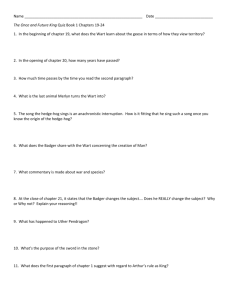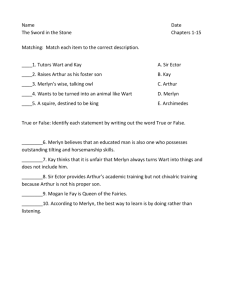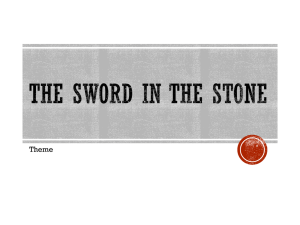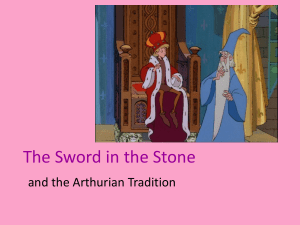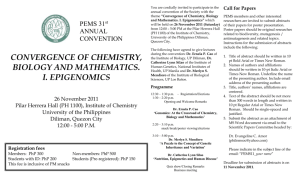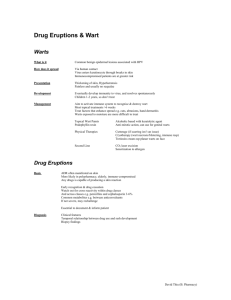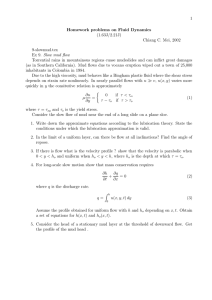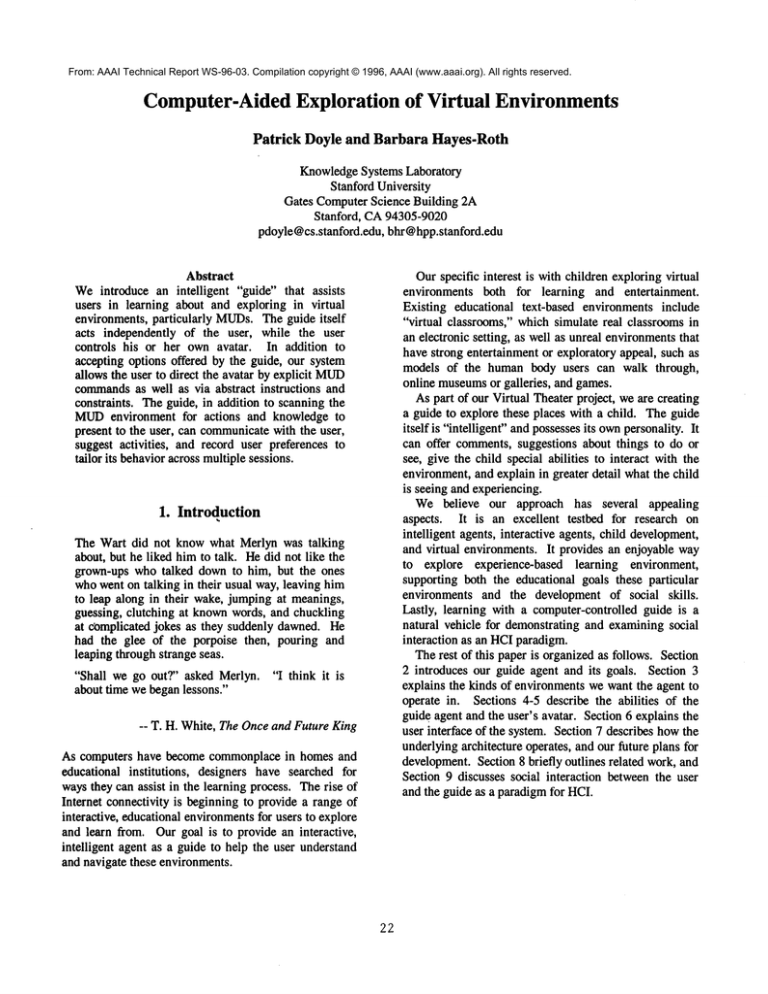
From: AAAI Technical Report WS-96-03. Compilation copyright © 1996, AAAI (www.aaai.org). All rights reserved.
Computer-AidedExploration of Virtual Environments
Patrick Doyle and Barbara Hayes-Roth
KnowledgeSystems Laboratory
Stanford University
Gates Computer Science Building 2A
Stanford, CA94305-9020
pdoyle@cs.stanford.edu, bhr@hpp.stanford.edu
Abstract
Weintroduce an intelligent "guide" that assists
users in learning about and exploring in virtual
environments, particularly MUDs.The guide itself
acts independently of the user, while the user
controls his or her own avatar. In addition to
accepting options offered by the guide, our system
allows the user to direct the avatar by explicit MUD
commandsas well as via abstract instructions and
constraints. The guide, in addition to scanning the
MUDenvironment for actions and knowledge to
present to the user, can communicatewith the user,
suggest activities, and record user preferences to
tailor its behavioracross multiple sessions.
Our specific interest is with children exploring virtual
environments both for learning and entertainment.
Existing educational text-based environments include
"virtual classrooms," which simulate real classrooms in
an electronic setting, as well as unreal environmentsthat
have strong entertainment or exploratory appeal, such as
models of the human body users can walk through,
online museumsor galleries, and games.
As part of our Virtual Theater project, we are creating
a guide to explore these places with a child. The guide
itself is "intelligent" and possesses its ownpersonality. It
can offer comments, suggestions about things to do or
see, give the child special abilities to interact with the
environment,and explain in greater detail what the child
is seeing and experiencing.
We believe our approach has several appealing
aspects. It is an excellent testbed for research on
intelligent agents, interactive agents, child development,
and virtual environments. It provides an enjoyable way
to explore experience-based learning environment,
supporting both the educational goals these particular
environments and the development of social skills.
Lastly, learning with a computer-controlled guide is a
natural vehicle for demonstrating and examining social
interaction as an HCIparadigm.
The rest of this paper is organized as follows. Section
2 introduces our guide agent and its goals. Section 3
explains the kinds of environments we want the agent to
operate in. Sections 4-5 describe the abilities of the
guide agent and the user’s avatar. Section 6 explains the
user interface of the system. Section 7 describes howthe
underlying architecture operates, and our future plans for
development.Section 8 briefly outlines related work, and
Section 9 discusses social interaction between the user
and the guide as a paradigmfor HCI.
1. Introduction
The Wart did not know what Merlyn was talking
about, but he liked him to talk. He did not like the
grown-ups who talked down to him, but the ones
whowent on talking in their usual way, leaving him
to leap along in their wake, jumping at meanings,
guessing, clutching at knownwords, and chuckling
at c~mplicated jokes as they suddenly dawned. He
had the glee of the porpoise then, pouring and
leaping through strange seas.
"Shall we go out?" asked Merlyn. "I think it is
about time we began lessons."
-- T. H. White, The Once and Future King
As computers have become commonplace in homes and
educational institutions,
designers have searched for
ways they can assist in the learning process. The rise of
Internet connectivity is beginning to provide a range of
interactive, educational environmentsfor users to explore
and learn from. Our goal is to provide an interactive,
intelligent agent as a guide to help the user understand
and navigate these environments.
22
As an example, suppose Merlyn and Wart are visiting
an historical
museum. They are standing in a room
exhibiting King John’s signing of the MagnaCarta.
Merlyn, scanning the room, is told that "King John" and
"MagnaCarta" are important educational elements, and
he requests more data from the room on each. He then
can present to the child the option ’Well me more about
King John" as an action. If the child should choose the
action, Merlynwill relate what he has learned - perhaps
biographical details on John’s life, his ambitions for
England, the prevalent social conditions leading to
MagnaCarta, and other related topics. The nature and
complexity of the information would be up to the
environment’s creator, but it can be presented through
Merlyn’sfriendly and decidedly idiosyncratic personality.
Merlyn’sthird task is to suggest activity to the child.
By keeping a record of places he has seen and actions he
knowsare available, he can offer to go back to these
places again. Either when requested by the child or as
part of his improvisational ability, Merlyn can make
suggestions about fun or educational things to do.
("Wart, I believe we should visit the Barber of Londonto
learn more about medieval medicine.").
Lastly, Merlyn should be able to play with the child.
"Play" is a loosely-defined term ranging here from
simple conversation to engaging in multi-player activities
in these virtual environments, such as a gameof chess.
Merlyn’s ability to performcomplextasks will be strictly
limited by the information he can take from the
environment,
but we hope to give him enough
instructions to makethese behaviors interesting.
2. Introducing the Guide: Goals and
Motivations
Our guide is called Merlyn, after T. H. White’s
befuddled seer in The Once and Future King (White,
1958). In White’s retelling of the Arthurian legends,
Merlyn guides a young Arthur (whomhe calls "Wart")
through a series of experiences designed to teach him
about the world and train him to become a king.
Through the help of Merlyn’s magic, Wart becomes a
fish, an ant, meets King Pellinore and the legendary
Questing Beast, and other wonders. The virtual
environments of today can offer similarly varied,
intriguing, and educational experiences to real children.
Merlynis intended to be a playmate, a teacher, and a
friend to the exploring child. His purpose is to makethe
MUDenvironment easier to understand and more
engaging to explore. There are four main tasks that
Merlynperforms to accomplish this.
First, Merlyn is an anthropomorphic friend to the
child. He is presented as a kindly old man, occasionally
confused1, sometimeswise, and invariably faithful. Bates
and others have written on the importance of emotion for
creating "believable agents" (Bates, 1994). Merlyn has
distinct, constant personality traits, such as kindliness,
governing his behavior, and in addition he has transient
moods(such as happiness or depression) that influence
his actions. The combination of these create an
emotionally-complex
friend for the child to interact with.
Also, the virtual environments we are exploring lend
themselves exceedingly well to anthropomorphizing
Merlyn. Since he appears to the child just as everyone
else does - as an animatedgraphic, or as a string of text
messageson a screen - the illusion of another person is a
strong one. Julia, the infamous MUD
robot, carried on
conversations with other MUD
users, and even whenthey
found out she was a computer program some users felt
that she was a friend (Mauldin, 1994).
Merlyn’s second task is to inform the child about the
environment. He2 has sensors that scan the environment
to learn what actions are currently available and what
details are knowable. Ideally, he will request data from
the MUDwhich will provide them in a format he can
then make available to the child on demand. Weforesee
creating annotated environments that provide such data
meant specifically for exploratory agents, to enable those
agents to organize and present information that would
not naturally fit into standarddescriptions.
3. Merlyn’s Habitat: Virtual Environments
As homes, educational
institutions,
and other
organizations have increasingly becomeconnected to the
Internet, interest has arisen in network-based,multi-user
virtual environments. Such systems provide evolving
and dynamic environments in which users, whether
children or adults, can explore and learn both by
conversing with others and through the use of interactive
gamesand tools contained in these environments.
One kind of such environments are MUDs(Multi-User
Dungeonsor Multi-User Dimensions). These text-based
systems allow manyusers simultaneously to connect to
virtual "worlds" composedof rooms, objects, and people.
Dependingon the design of a particular system, themes
vary from fantasy environments with dragons and
wizards, to futuristic exploration with spaceships and
aliens, to university settings complete with whiteboards,
lecturers,
and regular conferences. MUDsprovide
generic, programmable environments to support a wide
range of interactive applications.
This personality trait is a distinct advantage in an AI
agent.
2 Wehave already fallen into our anthropomorphictrap.
23
> look
On the Stage
This is the large wooden stage of a small theater used for improvisational
experiments.
The stage is bare but well-lit
by spotlights
high above. The
plush theater seats rise up all around the stage into the darkness.
-- There is one obvious exit: offstage.
William Shakespeare,
the Bard of Avon.
A banana cream pie.
> examine spotlights
High above the stage, brilliant white spotlights
illuminate
> get pie
Ok.
> eat pie
It doesn’t look very appetizing.
> say Hi, Will!
You exclaim: Hi, Will!
William Shakespeare
says: A most amiable day to you, sir.
>smile shakespeare
You smile happily at William Shakespeare.
William Shakespeare
bows with a flourish.
the actors.
Figure 1. A Typical Interaction on a MUD
moodsand interests of his own, as well as learning the
likes and dislikes of the user he is workingwith, and uses
these to guide his decision-making and improvisational
choices. The result is a more lifelike, friendly, and
entertaining wayof viewingthe virtual world.
Within a MUD,each user may pick up and manipulate
objects, movefrom one location to another, interact with
other beings, both alive and computer-controlled, or
perform more complex actions such as playing games,
sending electronic mail, or creating new objects. Figure
1 gives a typical exampleof interaction in a MUD.
Our current environments for exploration are MUDs.
As they are text-based, they have the advantages of being
easy for the agent to parse and communicatewith, and
they also relieve the designers (that is, us) from creating
complex graphics
and animations
in order to
communicatein the medium.Graphical variants on such
worlds are beginning to becomepopular as well, and in
time we see no reason why Merlyn’s architecture cannot
be transferred to new,morevisually exciting interfaces.
The child will act on the MUD
through Wart. Unlike
Merlyn, however, Wart only speaks or acts with the
child’s guidance. Wart merely records what he sees,
offers the child high-level commandsvia the agent
architecture,
and helps the child communicate with
Merlyn. From the child’s point of view, Wart is not an
independent entity; instead, he is an invisible character
that provides a channel for high-level communication
between the child and the environment.
The advantage of using our Virtual Theater systems to
control Merlynis that they bring with them capabilities
for interaction and improvisation. Merlyn is capable of
choosing actions either by being given high-level
requests by the user or on his own initiative. He has
4. Merlyn’sAbilities
Merlyn is operated on the virtual environment across an
ordinary socket connection by the Virtual Theater
system. To the MUD,he is just another character driven
from a remote location. However, his Virtual Theater
"brain" gives him a variety of abilities to explore, to
learn, and to adapt to his environmentand his user.
The basic traits Merlyntakes from the Virtual Theater
systemare his personality, moods,and ability to evaluate
and decide upon appropriate actions in context. Context
is created by the personality, mood,user requests, and
environment. However, unlike ordinary Virtual Theater
agents, Merlyn has several additional features designed
to make him flexible in an unknownenvironment, and
specifically to help him interact with an individual user.
First, Merlyn can scan the environment.
By
"scanning," we mean that he can request from the
environment a list of valid actions and a list of things
that can be examined. If the MUD
provides additional
hooks to provide ontological
knowledge of the
environment to an agent, our intention is for him to use
them as well. (Indeed, in our experiments we plan on
incorporating such knowledgein a testing environment.)
24
Merlynincorporates these actions into an action tree
structure. Whenevera new action is discovered, it is
added to the structure. He associates with new actions
their location and, whenpossible, their meanings. Data
about features of the environment (for example, the
description of the Forest Sauvage, factoids about ant
military structure, and the like) are stored in a keyword
database for later retrieval and presentation to the child.
In addition to storing information about the
environment, Merlyn also records Wart’s actions. In this
way he has an expanding database about what the child
has done, and can extrapolate to suggest repeating old
activities or trying new ones he has learned about that
have similar characteristics. The child can also explicitly
tell Merlynthat an activity on the MUD
is interesting or
uninteresting, and Merlyn will rank-order these actions
accordingly whenhe offers things to do.
Also, through the process of offering activities, Merlyn
receives feedback from the child. This feedback will be
used to weight Merlyn’s decisions. So, if Merlyn offers
to take the child to a museum,and the child indicates
that museumsaren’t interesting, he will turn to other
activities in the future. He can also be preset with
weights and suggestions for a particular MUD
if Merlyn
is being used to achieve particular educational goals.
child. In this way the interface is both Wart’s and
Merlyn’s gateway to the child. They also mean that
Merlyn can endow (to borrow a term from
improvisational theater) Wart with abilities he does not
ordinarily possess. Our expectation is that while Wart
will havea fairly small, consistent repertoire of actions to
provide, Merlynwill drive Wart to offer choices relating
to information retrieval (e.g., ’q’ell me about owls"),
multi-player activities ("Let’s becomefish") and other
options Merlyngathers from the environmentitself.
6. The Interface
The interface for our system has two goals. First, it
provides a windowdirectly onto the virtual environment,
currently a text-based MUD.Second, it provides support
for Wart’s suggested commands,Merlyn’s suggestions,
and any other information Merlyn wants to present
beyond the environment itself. In the current system we
have decided on a simple interface, handling most of
Merlyn’s discourse via the MUD
environment.
Although the interface between the user, Wart,
Merlyn, and the MUDcould be implemented as a simple
text windowalone, we have chosen to make a specialized
interface. The text windowdoes not offer enough control
to makethe interface easy to read and therefore does not
fit well with our target audience.
The windowedinterface consists of two parts, the text
window and the menu buttons. The text window is an
ordinary connection to the MUD,displaying whatever the
MUDdisplays and allowing the user to type commands
directly to the MUD
in it. In this way the child does not
feel the agents are hamperinghim or her from exploring,
and the sense of direct engagementis maintained.
The menubuttons are where the agent intelligences
are presented. Button options are a suggested list of
current actions for the child; pressing the button invokes
the action. Actions can either be atomic, and therefore
mappeddirectly onto the MUD
(such as "Smile") or can
involve more complex lists of commandsin the MUD
environment(such as "Go to the Forest").
Menubutton options change from one environment to
another and also from time to time. Options are under
the direct control of the Wart agent. He lists whichever
actions he believes are most appropriate for the child in
the current context. Whenthe context changes - by
movingto a new location, encountering a person, picking
up or putting downan object, or by the child changing
Wart’s moods- then the list of options is updated.
Merlyn also has control of the option list, though
indirectly. He can direct Wartto suggest activities to the
child explicitly, or he can simply make some of Wart’s
knownbut unavailable actions available, in which case
5. Wart’s Abilities
As we described earlier, the child interacts with the MUD
through Wart. Wart is a conceptual, rather than a
physical, entity; to all intents and purposes to the child
there is no agent present. As a result Wart’s features are
limited to gathering user data and presenting choices.
Fromthe child’s point of view, Wart is only a menuof
options provided with the interface. Wart’s job is to
control the options that appear, which change from area
to area and from time to time. The child can either type
directly on the text-based interface MUD,bypassing
Wart, or use the list of options to invoke high-level
commandsthrough Wart.
Wart does have moods, however. His moods are
meant to reflect the child’s moods, and the child has
control over them. Depending on Wart’s mood, offered
actions may change from "Greet Merlyn" to "Play a
Trick on Merlyn" or even "Kick Merlyn." The
configurable moods allow the child some control over
what appears as suggestions and options. Multiple,
interacting
moods give several axes on which to
prioritize actions, so they can apply not only to social
interaction but to presenting actions related to playing
games,exploring, learning, and the like.
Beyond this, Merlyn has control over Wart. He can
direct Wart to provide new or different choices to the
25
Wartcan decide whetherthey should be listed. This is
howMerlyncan endowWart with abilities temporarily;
portions of Wart’s permanentlist of actions maybe
available only whenMerlynturns themon, and become
unavailable when Merlyn turns them off. Explicit
direction is usedin cases whereit is not Wart’saction,
but Medyn’s,
that is relevant.
7. Implementation and Future Plans
The guide system is presently in the design stage.
Critical to our successare the issues of representationof
annotation,flexibility of the action trees usedby Merlyn
and Wart,andthe structure of Merlyn’sdatabasefor easy
access andcoordinationof the informationbe retrieves.
Herewebriefly outline the designof the system.
To support the guide system, the Virtual Theater
architecture performsthree majoroperations. It operates
two intelligent agents, one for Merlynand one for Wart.
It maintains simultaneous networkconnections to the
MUD
environmentfor each agent. Lastly, it operates the
visible interfacepresentedto the user.
The overarching system architecture coordinates
communication between the agents and the MUD
environmentvia networkconnections, so that the agents
are informed of all incomingdata and they can issue
commandsdirectly to the MUD.It also coordinates
agent commands
to the interface, which control the
appearanceof the actions menu,andthe user’s replies in
the interface. If the child types in the text window
of the
interface, that text is sent directly to the MUD
environmentthrough the Wartavatar; otherwise, if the
child choosesone of the action buttons on the options
menu,that requestis passedto the agentsfor processing.
Agents in the system use the BB1dynamiccontrol
system as their cognitive architecture (Hayes-Roth,
1985). BB1essentially runs a three-step cycle. First, an
agenda managernotices behaviors appropriate to the
situation triggered by current perceptionsandreasoning.
Second,a schedulerchoosesthe best available behavior
basedon the control plan, introducingsomecontrollable
"noise" in evaluating the most appropriate behavior.
Lastly, the executorexecutesthe chosenbehavior.
Thecontrol plan is a key feature of BB1.Since it can
be as abstract as desired, the schedulercan chooseamong
several acceptable behaviors. There can be multiple
simultaneous control plans, whose combinedweights
determinewhichaction is best. Eachindividual plan can
haveits ownstructure and maybe weightedby a variety
of factors, including user input, current mood,
personality, and environment. Since the control plan
itself is a data structure, executingactionscan modifyit,
therebychangingcriteria usedto schedulefuture actions.
26
Earlier Virtual Theater project architectures have
successfully been used in animated, graphical
improvisationand "puppet"systems(Hayes-Roth,et al.,
1994). The new features added in Merlyn and Wart
revolve around scanningenvironments,modifyingaction
choices to accommodatenew actions, and storing
acquiredknowledge
in databasesfor later access.
In this work,weintend to collaborate with educational
MUDdesigners to include annotation in their
environmentsthat Merlyncan use to advise the child.
Wealso intend to generate MUD
environments of our
ownfor Merlyn and the child to explore, The more
annotation, the greater Merlyn’s flexibility and
understandingof whathe sees. Initially, annotationsin
MUD
environmentswould be keywordsand action lists
that Merlyncould absorb directly into his databaseand
action choices. Eventually, wewantto enable Merlynto
obtain instructions for processesfromthe environment
so
that, for example, he could learn the rules to
encapsulatedgamesby askingthe systemto supply them.
8. Related Research
For some time research has been done on the social
aspects of virtual communities and on MUDsin
particular (Curtis, 1992; Curtis and Nichols, 1994).
addition to studies of howhumanbeingsinteract in textbased, virtual environments, research has been done
specifically on the issue of robots in MUDs.
Mauldin
created Julia, an agent that freely wanderedon a
TinyMUD,
exploring the environment, having limited
conversationswith other users, providingdirections, and
occasionallyfooling users into believing she wasa real
human(Mauldin, 1994).
Julia wastailored specifically for existing in a MUD
environment.Otherprojects, mostnotably JosephBates’
Oz project at Carnegie-MellonUniversity and Pattie
Maes’ autonomous agents at MIT have focused on
creating believable (Bates, 1994) and lifelike (Maes,
1995) intelligent agents, both for entertainment and
general purposes.
Weare attemptingto unify these lines of research, by
combiningthe naturally computer-basedinteraction of
virtual communitieswith a believable, lifelike agent.
Our Virtual Theater architectures allow us to create
intelligent, behavior-driven characters that have the
autonomy and complexity to behave in useful and
entertaining ways.Wecan put these characters in virtual
communities which are themselves expanding and
developing,andallow themto interact with other people
and newsituations, so that they are not lockedinto prescripted scenarios, but can advance with their
environments.
As a side issue of interacting
in unknown
environments and providing useful data about those
environments
to the user, data the agent could not create
itself, weare interestedin allowingthat agentto acquire
knowledgefrom its environment via annotation, and
presentwhatit learns in an easily-digestibleformatto the
user. In this respect our workis similar to the Guides
project at Applethat sought to use interactive, though
non-intelligent, guides to present information from
G-rolier’s Encyclopediathat related to early American
history (Oren,et al., 1995).
9. Social Interaction as an HCIParadigm
Somerecent research in human-computerinteraction
(Nass, Steuer, & Tauber, 1994; Nass, et al., 1995) has
suggested that humaninteraction with computersis
fundamentally social.
Nass describes this as the
"computersare social actors" paradigm(Nass, et al.,
1995). That is, the social rules weuse in dealing with
humansare applied in our interactions with computersas
well.
Our guide system of Merlyn and Wart provides an
excellent frameworkfor exploring this paradigm. The
child’s interactionwith the computer
is explicitly social.
Thecomputer,in the form of Merlynwith his querulous
comments,or in the formof Wartand his menubuttons,
provides conversationand choices relying uponordinary
rules of social interactionfor themto be sensible.
Social interaction is naturally morecomfortablefor
users than typing arcane commands
at a prompt. This is
especially true of our target users, whoare children By
providinga social atmosphereas a meansof interaction,
wecan increase their sense of direct engagement
with the
world. We can also strengthen the tendency to
anthropomorphize Merlyn, making him into a real
character with far more detail than we could ever
explicitly provide.
The social atmospherewe provide comesin the form
of Merlyn’sspokenfeedback, and also the nature of the
text weprovideon the options presentedto the child. If
the child feels that the option buttons are simplyiconic
representations of social communications,
then the sense
of conversationwith Merlynwill be natural and direct.
Sincethe goal of the project is to providethe child with a
friendly, familiar, andbelievable guide, weare hopeful
that our interface providesthis experience.
from Stanford’s Center for the Study of Languageand
Information and Office of TechnologyLicensing. We
thank Lee Brownston, Daniel Huber, Robert van Gent
and Daniel Rousseaufor suggestionson our design.
References
Bates, J. The role of emotion in believable agents.
Communications
of the ACM,1994, 37, 122-125.
Curtis, P. Mudding:Social Phenomenain Text-Based
Virtual Realities.
In Proceedings of the 1992
Conferenceon Directions and Implications of Advanced
Computing.Berkeley, 1992.
Curtis, P. and Nichols, D. MUDs
growup: social virtual
reality in the real world. In Digest of Papers, Spring
COMPCON
94. IEEE Computer Society Press, Los
Alamitos, 1994, 193-200.
Hayes-Roth,B. A blackboardarchitecture for control.
Artificial Intelligence,1985,26, 251-321.
Hayes-Roth,B., Sincoff, E., Brownston,L., Huard,R.,
and Lent, B. Directed improvisation.
Stanford
KnowledgeSystems Laboratory Report KSL-94-61,
1994.
Maes,P. Artificial life meets entertainment: lifelike
autonomousagents.
Communications of the ACM,
1995,38, 108-114.
Mauldin, M. ChatterBots, TinyMUDs,and the Turing
test: Entering the Loebner Prize Competition. In
Proceedingsof the AAAI1994 Conference. MITPress,
Cambridge,Mass., 16-21.
Nass, C., Steuer, J., and Tauber,E. Computers
are social
actors. In Proceedingsof the CHIConference. Boston,
Mass., 1994.
Nass, C., Moon,Y., Fogg,B., Reeves, B., and Dryer, D.
Can computer personalities be humanpersonalities?
International Journal of Human-Computer
Studies, 1995,
43, 223-239.
Oren, T., Salomon, G., Kreitman, K., and Don, A.
Guides: Characterizing the interface. In The Art of
Human-Computer
Interface Design, BrendaLaurel, ed.
Addison-Wesley,
Reading,Mass., 1995.
Acknowledgements
Our work has been supported by ARPAContract
N66001-95-D-8642-Subcontract #137-1 through
Teknowledge,Inc., a gift from Intel, and Seed Grants
White, T. H. The Once and Future King. Collins,
London,1958.
27

